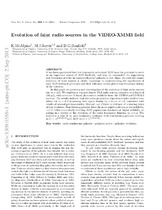| dc.contributor.author | McAlpine, K. | |
| dc.contributor.author | Jarvis, Matt | |
| dc.contributor.author | Bonfield, David G. | |
| dc.date.accessioned | 2018-02-07T08:50:11Z | |
| dc.date.available | 2018-02-07T08:50:11Z | |
| dc.date.issued | 2013 | |
| dc.identifier.citation | McAlpine, K. et al. Evolution of faint radio sources in the VIDEO-XMM3 field. Monthly Notices of the Royal Astronomical Society, 436(2): 1084 - 1095 | en_US |
| dc.identifier.issn | 0035-8711 | |
| dc.identifier.uri | http://dx.doi.org/10.1093/mnras/stt1638 | |
| dc.identifier.uri | http://hdl.handle.net/10566/3483 | |
| dc.description.abstract | It has been speculated that low luminosity radio-loud AGN have the potential to serve
as an important source of AGN feedback, and may be responsible for suppressing
star-formation activity in massive elliptical galaxies at late times. As such the cosmic
evolution of these sources is vitally important to understanding the significance of
such AGN feedback processes and their influence on the global star-formation history
of the universe.
In this paper we present a new investigation of the evolution of faint radio sources
out to z~2.5. We combine a 1 square degree VLA radio survey, complete to a depth of
100 μJy, with accurate 10 band photometric redshifts from the VIDEO and CFHTLS
surveys. The results indicate that the radio population experiences mild positive evo-
lution out to z~1.2 increasing their space density by a factor of ~3, consistent with
results of several previous studies. Beyond z=1.2 there is evidence of a slowing down
of this evolution. Star-forming galaxies drive the more rapid evolution at low redshifts,
z<1.2, while more slowly evolving AGN populations dominate at higher redshifts resulting in a decline in the evolution of the radio luminosity function at z>1.2. The
evolution is best fit by pure luminosity evolution with star-forming galaxies evolving
as (1 + z)2.47±0.12 and AGN as (1 + z)1.18±0.21. | en_US |
| dc.language.iso | en | en_US |
| dc.publisher | OUP | en_US |
| dc.rights | This is the pre-print version (from arXiv:1309.0358) of the article published online at: http://dx.doi.org/10.1093/mnras/stt1638 | |
| dc.subject | Radio continuum | en_US |
| dc.subject | Galaxies | en_US |
| dc.subject | Active galaxies | en_US |
| dc.subject | Evolution | en_US |
| dc.title | Evolution of faint radio sources in the VIDEO-XMM3 field | en_US |
| dc.type | Article | en_US |
| dc.privacy.showsubmitter | FALSE | |
| dc.status.ispeerreviewed | TRUE | |
| dc.description.accreditation | Web of Science | |

